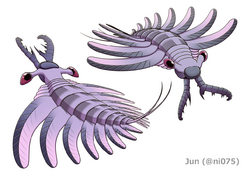Biology:Lyrarapax
| Lyrarapax | |
|---|---|

| |

| |
| Comparison of the frontal appendages of the two species | |
| Scientific classification | |
| Domain: | Eukaryota |
| Kingdom: | Animalia |
| Phylum: | Arthropoda |
| Class: | †Dinocaridida |
| Order: | †Radiodonta |
| Clade: | †Amplectobeluidae |
| Genus: | †Lyrarapax Cong et al., 2014[1] |
| Type species | |
| Lyrarapax unguispinus Cong et al., 2014
| |
| Species | |
Lyrarapax is a radiodont genus of the family Amplectobeluidae that lived in the early Cambrian period 520 million years ago. Its neural tissue indicates that the radiodont frontal appendage is protocerebral, resolving parts of the arthropod head problem and showing that the frontal appendage is homologous to the antennae of Onychophorans and labrum of euarthropods.[1] Its fossilized remains were found in Yunnan in southwestern China. A second species was described in 2016, differing principally in the morphology of its frontal appendages.[2] It is a small animal, measuring up to 8 cm (3.1 in) in total body length.[3]
Etymology
The scientific name "Lyrarapax" is a compound word of the Latin "lyra" (lyre) and "rapax" (predator), and is named after the outline of the body of this genus, which resembles a stringed instrument called a lyre, as well as its presumed predatory lifestyle.[1]
References
- ↑ 1.0 1.1 1.2 1.3 Peiyun Cong; Xiaoya Ma; Xianguang Hou; Gregory D. Edgecombe; Nicholas J. Strausfeld (2014). "Brain structure resolves the segmental affinity of anomalocaridid appendages". Nature 513 (7519): 538–42. doi:10.1038/nature13486. PMID 25043032. Bibcode: 2014Natur.513..538C.
- ↑ 2.0 2.1 Cong, Peiyun; Daley, Allison C.; Edgecombe, Gregory D.; Hou, Xianguang; Chen, Ailin (2016). "Morphology of the radiodontan Lyrarapax from the early Cambrian Chengjiang biota". Journal of Paleontology 90 (4): 663–671. doi:10.1017/jpa.2016.67. https://ora.ox.ac.uk/objects/uuid:5b38a48f-6c52-4f5f-898f-2db2e5858e90.
- ↑ "New suspension-feeding radiodont suggests evolution of microplanktivory in Cambrian macronekton". Nature Communications 9 (1): 3774. September 2018. doi:10.1038/s41467-018-06229-7. PMID 30218075. Bibcode: 2018NatCo...9.3774L.
Wikidata ☰ Q17409525 entry
 |

